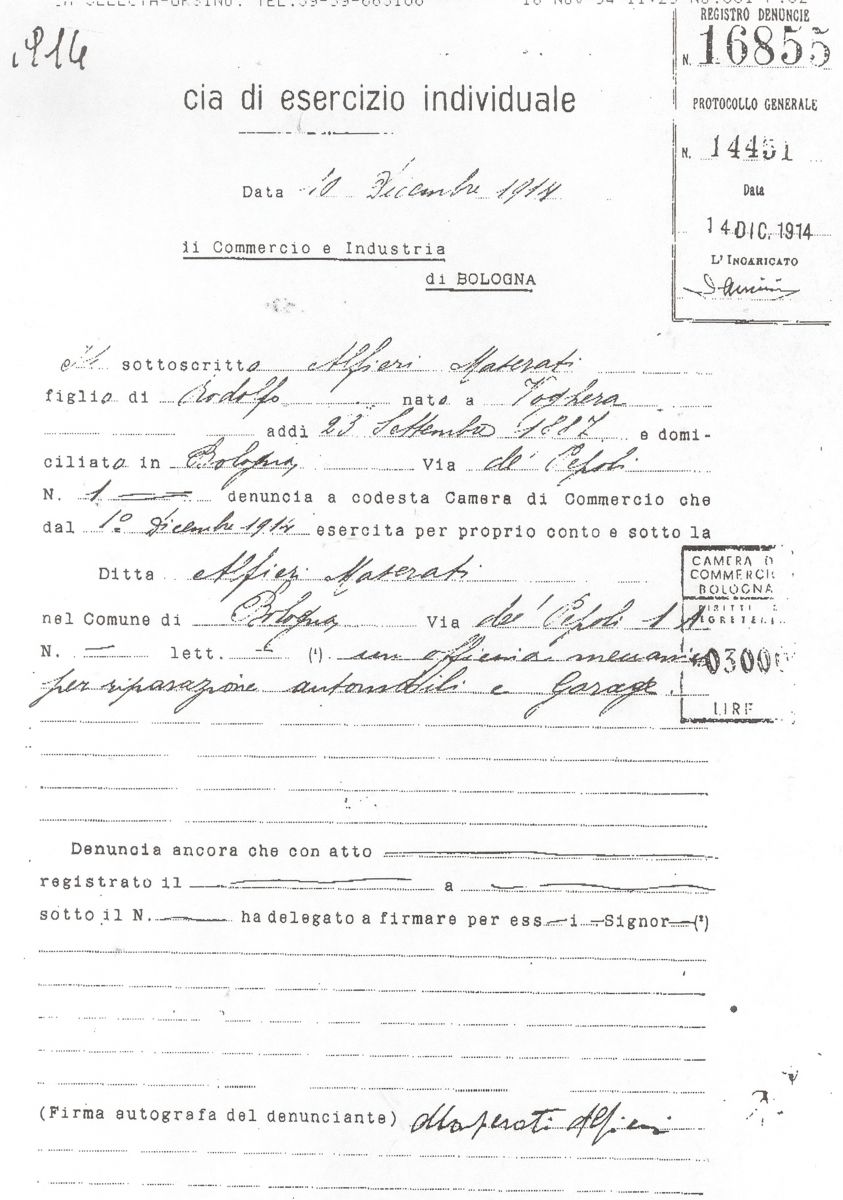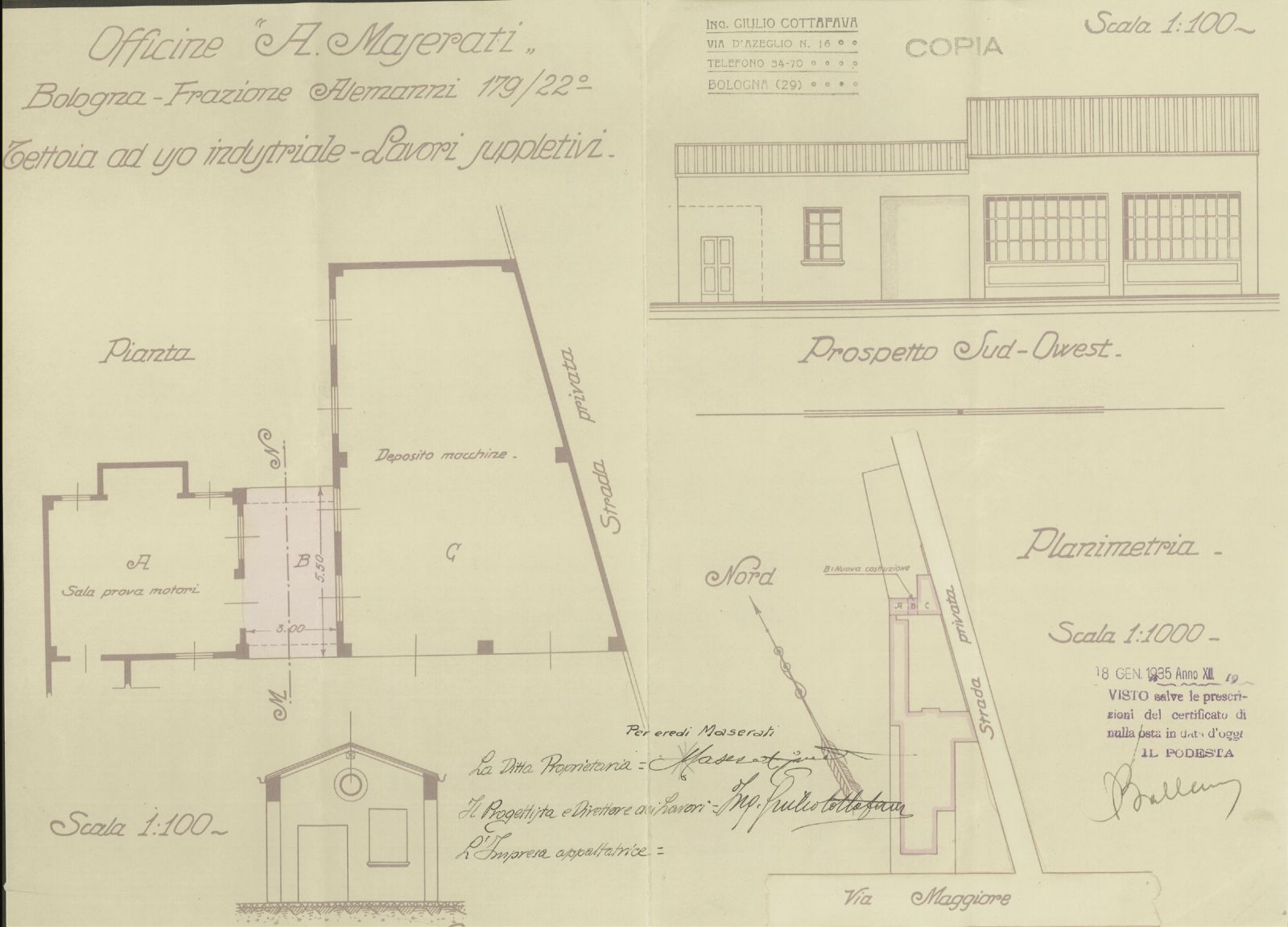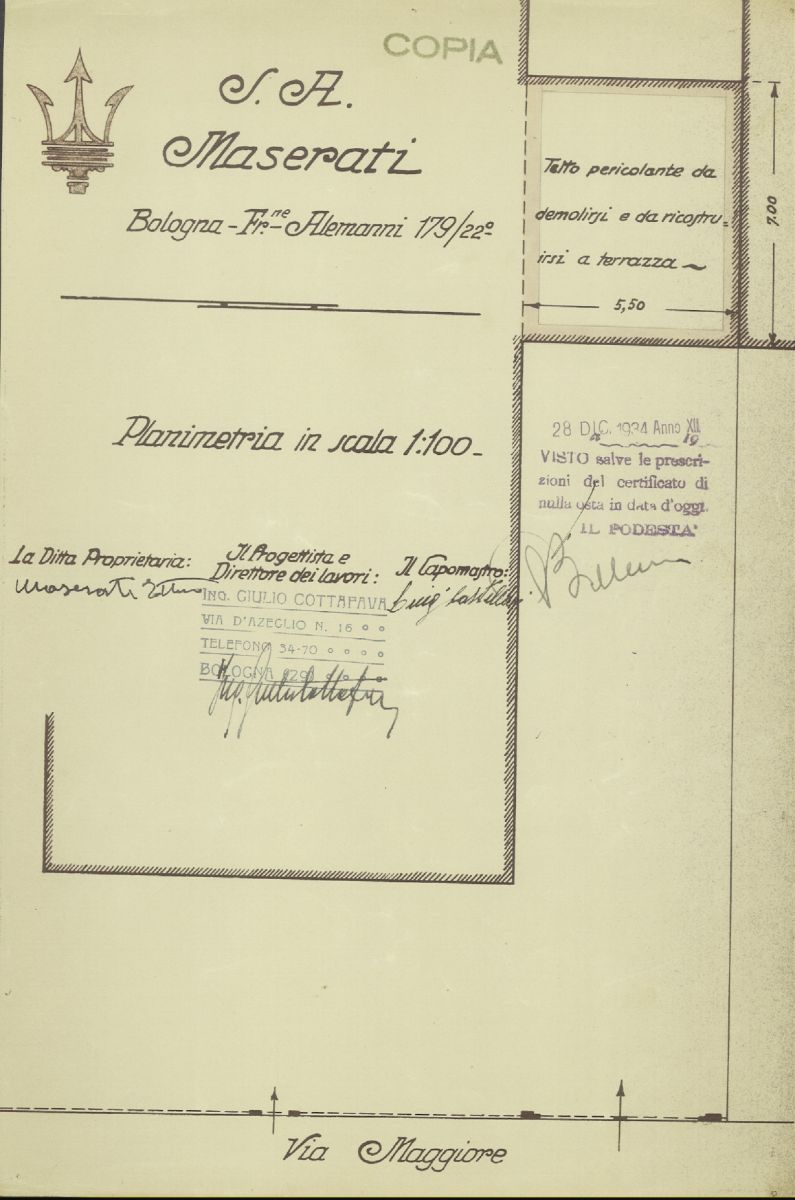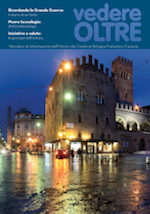
On December 1, 1914, in Bologna's historical centre began the activities of the car repair workshop, Garage Maserati Alfieri, located on the ground level of via de' Pepoli 1/a, an ancient road connecting via Santo Stefano to via Castiglione. In his application to obtain his license, Alfieri Maserati informs that "due to the size of the premises and the commercial address of the company, there is no actual garage work," and asks permission to also open a "car repair" workshop. In the public statement, as required by Municipal Police regulation, it is announced that an electric motor with a force of 2 HP will be used for the operation of a lathe, two drills and a grinder wheel for grinding irons used in the workshop.

The notices were intended to give the opportunity to those "who had reasonable grounds to oppose such a concession" to lodge a complaint, which in this case did not happen. The record and the future concession are signed by Francesco Zanardi, the first socialist mayor of Bologna, in place on July 15, 1914, after the June administrative elections won by the majority list presented by the Socialist Party. The concession expressly refers to the opening of a "car repair workshop located on the ground level of via de' Pepoli 1/a," with use of garages for cars. Above the entrance, a plate sign (2.50 m x 0.50 m) bearing the inscription GARAGE AND WORKSHOP ALFIERI MASERATI.
Alfieri, together with his brothers Ettore and Ernesto and five workers, begins the storage of Isotta Fraschini engines with the aim of building racing cars and get on racing circuits. This is how one of the greatest automotive brands came to be. With the outbreak of the First World War, Alfieri and Ettore are called to serve and the management of the garage workshop is entrusted to Ernesto, the youngest of the seven Maserati brothers, who were originally from the city of Voghera. During the war years, the brothers acquired considerable experience. Alfieri perfected and patented spark plugs for military airplanes in Milan and also opened a workshop on Corso Magenta for their production. Among other things, the Maserati spark plugs are placed in the engine of the aircraft that Gabriele D'Annunzio used for his flight over Vienna on August 9, 1918. When the Maserati brothers return to Bologna, the via de' Pepoli venue is now too small for their ambitions, even in view of the development of the automotive sector. On April 1, 1919, the business moved to Alemanni N° 179 2 A, in Pontevecchio district, where Alfieri asked the town to display three signs above the entrance doors with the words "Garage," "A. Maserati" and "Workshop," as can be seen from the sketch kept in the Municipal Historical Archives (p. 8197 of 1919). The building is owned by Enrico Nepoti, and it had been used since 1904 as a wholesale warehouse and retail sales of pottery, glassware, faience, flasks, demijohns, located on via Emilia Levante (current No. 80), almost at the corner of the actual via Marcello Oretti, at the time a private road. The new place houses the garage for cars and the mechanical workshop, while via de' Pepoli remains used as a warehouse. Nepoti issues a declaration authorizing the use of his premises "as a workshop and garages also operating electric motors and machine tools."
In the archive documents, it is clear that "the aforementioned plant cannot give rise to complaints, especially since the tenants close by have given their support in writing." In fact, the six families who live in the same building as Nepoti agree to the workshop operations on the ground floor. In August of the same year, Alfieri requested the display of two other signs with the words "Michelin tires depot (1919)". The purchase of a plot of land in Pontevecchio by Alfieri is also documented by the Historical Archives; it will later be extended to include the whole area on which stood the building. In March 1921, Maserati asked the city for permission to build on their property and next to the workshop a test room where engines would be tested, as is shown on the drawing of the "Engine Test Room to be built at the Maserati Alfieri Workshop - Fraz. Alemanni 179." The separate building's dimensions are 6 m x 5 m and about 5 m high and is at the end of the property.

During the following years, the company built three areas used as workshops in 1926, connecting them to the rest of the building with a new structure designed by engineer Giulio Cottafava with a characteristic circular window on the east front in 1934. In the same year, in a planning permit for the demolition of a roof and the reconstruction of a terrace, for the first time in the documentation of the archives appears the Maserati coat of arms, the trident inspired by the Statue and Fountain of Neptune, by Mario Maserati, an artist and a painter, and the only brother not sharing their passion for engines and racing. The fame of Maserati is further strengthened in motor racing and in the advanced manufacturing projects of racing cars under the guidance of Alfieri, who suffers a serious injury during a race in Messina in 1927. The consequences of the accident and his subsequent surgery are the causes of his untimely death March 3, 1932, at age 44. The mayor stated that to honour the memory of Alfieri Maserati the first-class hearse should be used for transporting his remains to his grave in Certosa. The city chronicles report a great participation of the city to the news of the death of Alfieri, who has considerably improved the automotive industry while also giving prestige to the city.
Alfieri's tomb is the work of artist Mario Sarto who, on behalf of the Maserati family, presented the project for the marble memorial of lot 20 located in the courtyard of Claustro IX of the Certosa cemetery, as shows the drawing in the city's historical archives. The stone is made of red vallecamonica porphyry, the base is in green diorite with bronze bust and eagles, placed in the entrepreneurs’ gallery with the inscription "to the pioneer of the engine and speed," in the memory of "sportsmen, admirers and friends." The death of Alfieri marks the history of Maserati. The commitment of brothers Ernesto, Ettore and Bindo is concentrated in the activity marked by the founder until 1939, when the company is sold to the financial group of the Orsi family in Modena. The Maserati remains in the memory of the Bolognese as evidenced by Estenio Mingozzi: "The small workshop was just a few steps from the school, just across via Emilia. It was perfectly established, in the outskirts of the city where lived ordinary people, in their heart and their pride. When you read in the Monday papers that the Maserati has won, you have won too. They were part of your life because you saw them every day. Waking up many times in the middle of the night when something went wrong and they had to develop the engine at the last minute, whatever the time... People used to speak in homes, bars and schools about the workshop and brothers Alfieri, Bindo, Ernesto and Ettore Maserati, as though they were a myth.





.png)